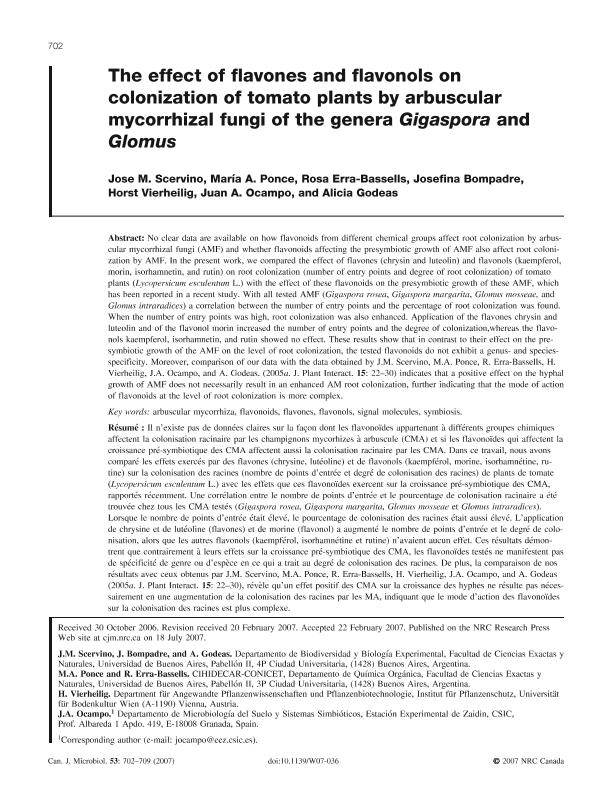Mostrar el registro sencillo del ítem
dc.contributor.author
Scervino, Jose Martin

dc.contributor.author
Ponce, María Alejandra

dc.contributor.author
Erra Bassells, Rosa
dc.contributor.author
Bompadre, Maria Josefina

dc.contributor.author
Vierheilig, Horst
dc.contributor.author
Ocampo, Juan A.
dc.contributor.author
Godeas, Alicia Margarita

dc.date.available
2022-09-26T17:04:34Z
dc.date.issued
2007-06
dc.identifier.citation
Scervino, Jose Martin; Ponce, María Alejandra; Erra Bassells, Rosa; Bompadre, Maria Josefina; Vierheilig, Horst; et al.; The effect of flavones and flavonols on colonization of tomato plants by arbuscular mycorrhizal fungi of the genera Gigaspora and Glomus; National Research Council Canada-NRC Research Press; Canadian Journal Of Microbiology; 53; 6; 6-2007; 702-709
dc.identifier.issn
0008-4166
dc.identifier.uri
http://hdl.handle.net/11336/170462
dc.description.abstract
No clear data are available on how flavonoids from different chemical groups affect root colonization by arbuscular mycorrhizal fungi (AMF) and whether flavonoids affecting the presymbiotic growth of AMF also affect root colonization by AMF. In the present work, we compared the effect of flavones (chrysin and luteolin) and flavonols (kaempferol, morin, isorhamnetin, and rutin) on root colonization (number of entry points and degree of root colonization) of tomato plants (Lycopersicum esculentum L.) with the effect of these flavonoids on the presymbiotic growth of these AMF, which has been reported in a recent study. With all tested AMF (Gigaspora rosea, Gigaspora margarita, Glomus mosseae, and Glomus intraradices) a correlation between the number of entry points and the percentage of root colonization was found. When the number of entry points was high, root colonization was also enhanced. Application of the flavones chrysin and luteolin and of the flavonol morin increased the number of entry points and the degree of colonization,whereas the flavonols kaempferol, isorhamnetin, and rutin showed no effect. These results show that in contrast to their effect on the presymbiotic growth of the AMF on the level of root colonization, the tested flavonoids do not exhibit a genus- and species-specificity. Moreover, comparison of our data with the data obtained by J.M. Scervino, M.A. Ponce, R. Erra-Bassells, H. Vierheilig, J.A. Ocampo, and A. Godeas. (2005a. J. Plant Interact. 15: 22-30) indicates that a positive effect on the hyphal growth of AMF does not necessarily result in an enhanced AM root colonization, further indicating that the mode of action of flavonoids at the level of root colonization is more complex.
dc.format
application/pdf
dc.language.iso
eng
dc.publisher
National Research Council Canada-NRC Research Press

dc.rights
info:eu-repo/semantics/openAccess
dc.rights.uri
https://creativecommons.org/licenses/by-nc-sa/2.5/ar/
dc.subject
ARBUSCULAR MYCORRHIZA
dc.subject
FLAVONES
dc.subject
FLAVONOIDS
dc.subject
FLAVONOLS
dc.subject
SIGNAL MOLECULES
dc.subject
SYMBIOSIS
dc.subject.classification
Biología Celular, Microbiología

dc.subject.classification
Ciencias Biológicas

dc.subject.classification
CIENCIAS NATURALES Y EXACTAS

dc.title
The effect of flavones and flavonols on colonization of tomato plants by arbuscular mycorrhizal fungi of the genera Gigaspora and Glomus
dc.type
info:eu-repo/semantics/article
dc.type
info:ar-repo/semantics/artículo
dc.type
info:eu-repo/semantics/publishedVersion
dc.date.updated
2021-04-28T21:39:15Z
dc.journal.volume
53
dc.journal.number
6
dc.journal.pagination
702-709
dc.journal.pais
Canadá

dc.description.fil
Fil: Scervino, Jose Martin. Consejo Nacional de Investigaciones Científicas y Técnicas. Oficina de Coordinación Administrativa Parque Centenario. Instituto de Investigaciones en Biociencias Agrícolas y Ambientales. Universidad de Buenos Aires. Facultad de Agronomía. Instituto de Investigaciones en Biociencias Agrícolas y Ambientales; Argentina
dc.description.fil
Fil: Ponce, María Alejandra. Consejo Nacional de Investigaciones Científicas y Técnicas. Oficina de Coordinación Administrativa Ciudad Universitaria. Centro de Investigaciones en Hidratos de Carbono. Universidad de Buenos Aires. Facultad de Ciencias Exactas y Naturales. Centro de Investigaciones en Hidratos de Carbono; Argentina
dc.description.fil
Fil: Erra Bassells, Rosa. Consejo Nacional de Investigaciones Científicas y Técnicas. Oficina de Coordinación Administrativa Ciudad Universitaria. Centro de Investigaciones en Hidratos de Carbono. Universidad de Buenos Aires. Facultad de Ciencias Exactas y Naturales. Centro de Investigaciones en Hidratos de Carbono; Argentina
dc.description.fil
Fil: Bompadre, Maria Josefina. Consejo Nacional de Investigaciones Científicas y Técnicas; Argentina. Universidad de Buenos Aires. Facultad de Ciencias Exactas y Naturales. Departamento de Biodiversidad y Biología Experimental; Argentina
dc.description.fil
Fil: Vierheilig, Horst. Universidad de Granada; España
dc.description.fil
Fil: Ocampo, Juan A.. Universidad de Granada; España
dc.description.fil
Fil: Godeas, Alicia Margarita. Universidad de Buenos Aires. Facultad de Ciencias Exactas y Naturales. Departamento de Biodiversidad y Biología Experimental; Argentina. Consejo Nacional de Investigaciones Científicas y Técnicas; Argentina
dc.journal.title
Canadian Journal Of Microbiology

dc.relation.alternativeid
info:eu-repo/semantics/altIdentifier/url/https://cdnsciencepub.com/doi/10.1139/W07-036?url_ver=Z39.88-2003&rfr_id=ori:rid:crossref.org&rfr_dat=cr_pub%20%200pubmed
dc.relation.alternativeid
info:eu-repo/semantics/altIdentifier/doi/http://dx.doi.org/10.1139/W07-036
Archivos asociados
